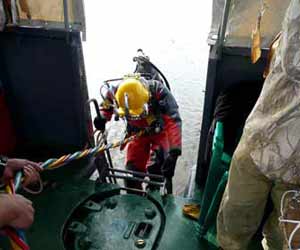Types of Commercial Diving – Hazmat, Oil, Inland, Nuclear
Commercial diving is a great career avenue. It’s an awesome job, doing relatively routine things, in bizarre environments. Imagine welding a bridge support 40 meters deep in a river with a strong current, inspecting the base of an offshore oil rig in the North Atlantic, or repairing a sluice gate in Guyana. It’s way better than shuffling papers in a cubicle.
When most people think of commercial diving, they usually picture offshore diving. Other types of commercial diving include inland, HazMat, and nuclear. Each type of diving is unique and you’ll want to consider this when you seek training and certifications or a job.

Offshore diving is the usual entry point for newbie commercial divers. It is decent pay, dangerous conditions, and long hours. You may live on an oilrig in the Gulf of Mexico or the North Atlantic for weeks on end. Most of the work is surface supplied air dives that involve doing maintenance on existing oil rigs or building new offshore structures. Offshore dive work is a true test to see if you can handle the commercial diving world.
Inland diving is commercial diving that takes place in lakes, dams, rivers, sewers, harbors, or canals. It is similar to offshore diving, but usually involves engineering or surveying work in freshwater. You’ll be inspecting bridges and dams for structural integrity or helping to build new underwater structures. The advantage of onshore diving is that divers can live at home and have time off, but they probably won’t make as much money as an offshore diver.
HazMat diving is the most dangerous type of commercial diving. Before you can get into this commercial diving niche, you’ll need lots of experience and you’ll have to have mastered all the diving skills. HazMat diving takes lots of special considerations. Special vaccinations are necessary, decontamination plans for both divers and equipment are a must, backup rescue divers need to be close by, and equipment and weight considerations need to be made for every dive. Hazmat divers often do the same surveying, construction, building, repairing jobs that offshore and inland divers do, but they do it in polluted and contaminated water. They may have to penetrate sewer pipes, control and clean up pollution spills, fix pumps at landfills, patch septic tanks, find bodies, or recover objects. MSNBC calls HazMat diver jobs one of the 10 worst jobs in science. This is because all of HazMat diving takes place in dangerous contaminated water. Because of the danger, you’ll be paid a lot to do it.
Nuclear diving involves diving in water that has been exposed to radiation. It sounds dangerous because it is. Radiation is scary because you don’t know it’s there. You can’t see it, feel it, touch it, smell it, but it can still kill you. Nuclear diving is a demanding job. You’ll spend your time in hot water doing the same old commercial diving skills that other commercial divers use. The big key as a nuclear diver is to have a solid crew working with you, using proper radiation diving equipment, and following all safety precautions.
Commercial diving is a great way to make money. It’s an exciting career with lots of branches to choose from. All of them are guaranteed to be an adventure.

